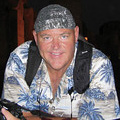
|  |  |  Vallarta Living | Art Talk | April 2009 Vallarta Living | Art Talk | April 2009  
Photo Tip of the Week: Learning How To Photograph Fireworks - Part 2
 Larry and Linda Bennett - PVNN Larry and Linda Bennett - PVNN

| | Photo Tips of the Week are written by Larry Bennett, a professional photographer living in Puerto Vallarta. To view more of his work, visit LarryBennettPhotography.com. |  |
This week's article will start off where last week's left off, talking about shooting images of fireworks. Remember, the 11th Annual Fireworks Symposium runs through April 24, 2009 in beautiful Puerto Vallarta, Mexico.

Settings, Shutter Speed and Aperture

F8 to F11 are good settings for fireworks, itís the prime spot for maximum quality and just kind of a failsafe setting for shooting a lot of stuff. Letís review, DSLR and point and shoot users should all be in M or manual, then to B or bulb, on F8-F11 and youíre now ready to shoot away. Another way that I have shot fireworks and another option for some is to set your cameras to M or manual and set your shutter speed for 3 to 8 seconds - depending on the speed of the fireworks display. You will not achieve the same accuracy as shooting in B or bulb but this is a second option and you should get some great shots using this option as well.

Letís touch base (real fast) on white balance. Most camera settings are set at 5200 on the Kelvin scale. What scale? Kelvin. Someday I will write an article solely on the Kelvin scale, it is a fun and interesting subject and one of the most confusing topics next to F stop in photography. Anyway set your white balance at 5600 to 5800, those shooting with a DSLR will see some difference in post processing.

Focusing

Turn your AF (or auto-focus) off. You will go totally nuts if you leave it on because your AF is not going to find the fireworks burst and if it does, the fireworks burst is over before the AF will process the information. Here is what I do, very simple, turn off auto-focus. Manual focus is now on; turn your manual focus on your lens all the way over to infinity then back just a hair and I mean just a hair. This particular setting will be used for most locations; however, if you are in the trenches and up very close, do the same but check it TTL (through the lens) for maximum sharpness. This method seems to work for me while shooting fireworks.

A Few Additional Tips

For some reason when shooting in B or bulb, I use more battery power, so I always carry an extra battery in my pocket (not in the car or my wifeís purse). Also a small flash light is very helpful. And donít forget a small little quirky thing, after all my settings are done and the focus is where I want it to be, I like to cover the eye piece. Covering the eye piece keeps from some bleed over into your mirror and then on to the sensor, when itís locked up and using the B or bulb mode. One additional item for my DSLR friends, turn your long noise exposure ON (it is sometimes called NR or noise reduction.)

The Rocket Science of Photographing Fireworks

The next few paragraphs are the real science of shooting fireworks images. When the fireworks go up, open the shutter, when they go down release it. Sounds simple. Okay, letís get more technical.

I like the whump method, yeah, the whump method. When you hear the whump count one, two, then push and hold open your shutter until gravity has won and the fireworks are falling to the ground.

Some fireworks images I have seen are explosion only, some of the most colorful and brilliant lights come as they fall. This is all personal preference and some of you might not like the whump method and may wish to create your own method, maybe referred to as the launch.

Something I find really fun and have been doing for a few years involves building my own exposure. See me through on this. I build my own exposures (short or long) based on the fireworks I want in my image.

Hereís how I do it. Using the B or bulb setting, when I hear the whump, because Iím used to the whump, I wait for two seconds then I open my shutter and hold it open. Okay instead of releasing the shutter, I cover the lens with a piece of black foam core board and wait until the next fireworks or even until the color I want appears, then I quickly remove the black cover without shaking or moving the camera or lens. I do this for three, sometimes four, big beautiful bursts and it works and works well. You just have to be quick, patient, and very careful to not move your equipment. Be creative and most of all, F8 and be there!

1 | 2 

 Photo Tips of the week are written by Larry Bennett, a professional photographer living in Puerto Vallarta. These tips are to be just tips, refer to your cameras owner's manual for specifics on your camera. Readers are welcome to enjoy Larry's website at LarryBennettPhotography.com. Photo Tips of the week are written by Larry Bennett, a professional photographer living in Puerto Vallarta. These tips are to be just tips, refer to your cameras owner's manual for specifics on your camera. Readers are welcome to enjoy Larry's website at LarryBennettPhotography.com.

Click HERE for more Photo Tips from Larry Bennett. |

 |
|  |



